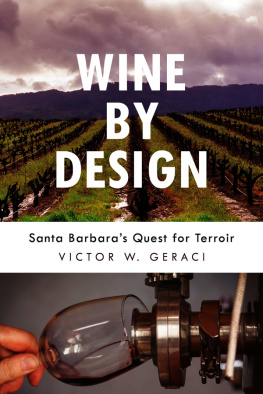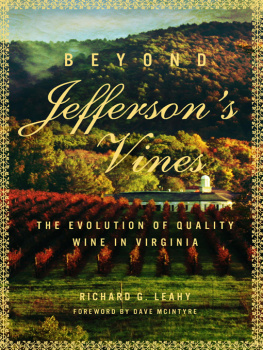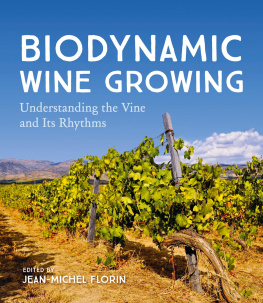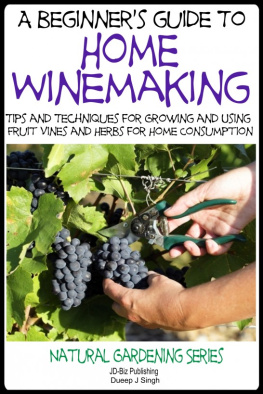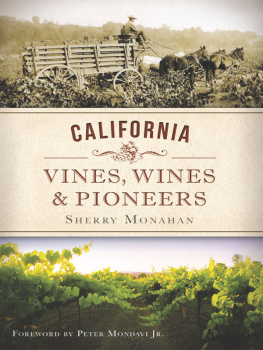Copyright 2013 University of Pennsylvania Press
All rights reserved. Except for brief quotations used for purposes of review or scholarly citation, none of this book may be reproduced in any form by any means without written permission from the publisher.
Published by
University of Pennsylvania Press
Philadelphia, Pennsylvania 19104-4112
www.upenn.edu/pennpress
Printed in the United States of America on acid-free paper
10 9 8 7 6 5 4 3 2 1
Library of Congress Cataloging-in-Publication Data
Hannickel, Erica.
Empire of vines : wine culture in America / Erica Hannickel.
1st ed.
p. cm. (Nature and culture in America)
Includes bibliographical references and index.
ISBN 978-0-8122-4559-2 (hardcover : alk. paper)
1. ViticultureUnited StatesHistory19th century. 2. Wine and wine makingUnited StatesHistory19th century. 3. GrapesUnited StatesHistory19th century. I. Title. II. Series: Nature and culture in America.
TP557.H358 2013
663'.20973dc23 2013015746
For my grandmothers
The first record of America is also a record of its grapes.
Liberty Hyde Bailey
Sketch of the Evolution of Our Native Fruits, 1898
How beautifully prophetic is the emblematic vine of the destiny of man.
Jno. S. Reid
The Horticulturist, 1862
The vine and the American people are not unlike [one another]. They require room to spread themselves, and do not thrive under restraint.
G. W. Campbell
The Horticulturist, 1874
The gold of the Sierra did not build cities as surely as will the vines of its foothills.
Charles A. Wetmore
Californian, 1880
INTRODUCTION
Grape Culture, National Culture
C ARRYING WITH IT a picture of rustic elegance, sun-drenched hillsides, and verdant grapevines running parallel in organized prospect, wine growing easily outpaces romanticized images of other agricultural goods. To many Americans, vineyard scenes represent the trappings of a noble society. A 2005 PBS documentary, The Cultivated Life: Thomas Jefferson and Wine, argues as much. The narrator, over images of vines heavy with luscious grapes, explains that Jefferson's vision for the quality of American wine has been realized, but his dream of a genteel agrarian society has largely been relegated to the pages of history books. Except in one instancethe American vineyard. Jefferson's ideal agrarian society was one populated by independent farmers, men removed from the cash economy who owned their own land, performed their own labor, and were stalwart in the face of economic change and political tomfoolery. Although it has been two centuries since Jefferson planted his own (largely failed) vineyards at Monticello, several contemporary winemakers interviewed in the documentary agree that Jefferson's ideals are embodied today in American vineyards.
The suggestion that wine growing is still a yeoman enterprise is, to put it plainly, wildly inaccurate. Against PBS's minikin scene, wine is actually a $122 billion-dollar industry in America, and the United States is currently the world's fourth-leading wine producer, behind France, Italy, and Spain. As of 2010, California made 90 percent of all American wine, and 21 million tourists visit the state's 535,000 acres of vineyards annually. (The next largest wine-producing states are Washington, Oregon, and New York.) Although many growers might be loath to admit it, the contemporary U.S. wine industry reflects global industrial agribusiness at its most successful. Large wine producers are deeply dependent on national and international markets, and advanced technology is used throughout the many stages of production. One of the most distinctive features of industrial agriculturemonocropping, growing only one type of plant across a wide areais ubiquitous in grape production, and its benefits and risks are no different than for any other crop. As with all monocrops, a variety of pests and diseases plague contemporary vineyards, and most growers still find chemical pesticides the easiest and most effective method of pest control. Methyl bromide, a highly toxic, ozone-depleting pesticide, is used regularly as a fumigant to sterilize soils prior to planting wine grapes. Its use in California was at a record high in 1992, with over 18 million pounds administered, and though its application has been on the decline since then, in 2009 over 5.4 million pounds were still spread annually.
This less-than-flattering industry overview comes on the heels of decades of high-profile vineyard labor activism in California, headed by Cesar Chavez from 1965 to 1993. Immigrant bracero programs, in effect throughout the postwar Southwest, had brought hundreds of thousands of Mexican laborers into the United States. Suffering poor pay, harassment, and often dangerous working conditions, by the 1960s, Chavez and the United Farm Workers drew inspiration from the civil rights movement, and mounted a successful table grape boycott in 1970. It resulted in 150 contracts with growers who at the time produced 85 percent of California's table grapes. The contracts covered 20,000 farmworker jobs. Provisions included union worker security, grievance procedures, and health plans; an improved work environment, including rest breaks, field toilets, and drinking water; and finally, strictly enforced pesticide use, including banning DDT. These contracts, however, have been under assault by conservative lawmakers from their beginning, and although the UFW mounted other successful lettuce and grape boycotts (including one against Gallo brand wines) over the decades, its organizing power has been in steady decline since 1973. From health, safety, and environmental standpoints, many would agree that industrial vineyard labor conditions today, just as temporary labor conditions for any other industrial monocrop, leave much to be desired.
In the midst of these industry realities, the Wine Institute, the major advocacy group for more than a thousand wineries and affiliated businesses in California, is keen to capitalize on wine's continuing, if inaccurate, yeoman pastoral image. Wine's sylvan narrative has been perpetuated internationally for centuries, and is the basis for what journalist Mike Weiss has called the Story of contemporary wine growing. In the Wine Institute's vision of wine growing, there is continuous cultivation of natural abundance, Old World refinement reinvigorated in the New World, and local craft rooted in the land. Supposedly, repeating yeoman lore of old, American viticulture comes from, and helps build, healthy natural spaces and communities. The Wine Institute is of course a booster organization for the industry, and this flyer reflects its central sales pitch. Yet it would be hard to underestimate the power of the story they sell.



